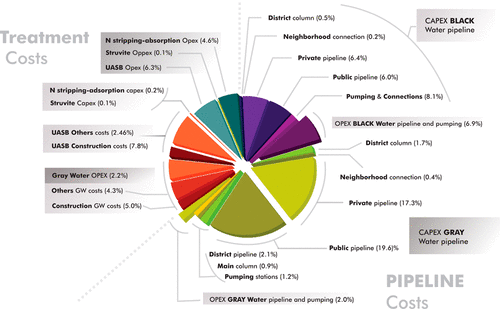当前位置:
X-MOL 学术
›
Environ. Sci. Technol.
›
论文详情
Our official English website, www.x-mol.net, welcomes your
feedback! (Note: you will need to create a separate account there.)
The Economics of Wastewater Treatment Decentralization: A Techno-economic Evaluation
Environmental Science & Technology ( IF 10.8 ) Pub Date : 2018-07-17 , DOI: 10.1021/acs.est.8b01623 Manel Garrido-Baserba 1, 2 , Sergi Vinardell 3 , María Molinos-Senante 4, 5 , Diego Rosso 1, 2 , Manel Poch 3
Environmental Science & Technology ( IF 10.8 ) Pub Date : 2018-07-17 , DOI: 10.1021/acs.est.8b01623 Manel Garrido-Baserba 1, 2 , Sergi Vinardell 3 , María Molinos-Senante 4, 5 , Diego Rosso 1, 2 , Manel Poch 3
Affiliation

|
The existing wastewater treatment infrastructure has not adequately established an efficient and sustainable use of energy, water, and nutrients. A proposed scheme based on source separation and water-efficient use is compared to the current wastewater management paradigm (one largely based on activated sludge) using techno-economic terms. This paper explores the economic viability of adopting more sustainable management alternatives and expands the understanding of the economics of decentralization and source-separation. The feasibility of three different potential types of source-separation (with different levels of decentralization) are compared to the conventional centralized activated sludge process by using recognized economic assessment methodologies together with widely accepted modeling tools. The alternatives were evaluated for two common scenarios: new developments and retrofit due to the aging of existing infrastructures. The results prove that source-separated alternatives can be competitive options despite existing drawbacks (only when countable incomes are included), while the hybrid approach resulted in the least cost-effective solution. A detailed techno-economic evaluation of the costs of decentralization provides insight into the current constraints concerning the paradigm shift and the cost of existing technologic inertia.
中文翻译:

污水处理权下放的经济学:技术经济评价
现有的废水处理基础设施尚未充分建立起对能源,水和养分的有效和可持续利用。使用技术经济术语将基于源分离和节水利用的拟议方案与当前的废水管理范式(主要基于活性污泥)进行了比较。本文探讨了采用更多可持续管理替代方案的经济可行性,并扩大了对权力下放和源头分离经济学的理解。通过使用公认的经济评估方法和广泛接受的建模工具,将三种不同类型的源头分离方法(分散程度不同)的可行性与传统的集中式活性污泥法进行了比较。评估了两种常见方案的替代方案:由于现有基础架构的老化而进行的新开发和改造。结果证明,尽管存在弊端(仅当包括可计数的收入时),但按源分隔的替代方案仍可能是竞争性选择,而混合方法导致了成本效益最低的解决方案。对权力下放成本进行详细的技术经济评估,可以深入了解有关范式转换和现有技术惯性成本的当前约束条件。而混合方法则导致成本效益最低的解决方案。对权力下放成本进行详细的技术经济评估,可以深入了解有关范式转换和现有技术惯性成本的当前约束条件。而混合方法则导致成本效益最低的解决方案。对权力下放成本进行详细的技术经济评估,可以深入了解有关范式转换和现有技术惯性成本的当前约束条件。
更新日期:2018-07-18
中文翻译:

污水处理权下放的经济学:技术经济评价
现有的废水处理基础设施尚未充分建立起对能源,水和养分的有效和可持续利用。使用技术经济术语将基于源分离和节水利用的拟议方案与当前的废水管理范式(主要基于活性污泥)进行了比较。本文探讨了采用更多可持续管理替代方案的经济可行性,并扩大了对权力下放和源头分离经济学的理解。通过使用公认的经济评估方法和广泛接受的建模工具,将三种不同类型的源头分离方法(分散程度不同)的可行性与传统的集中式活性污泥法进行了比较。评估了两种常见方案的替代方案:由于现有基础架构的老化而进行的新开发和改造。结果证明,尽管存在弊端(仅当包括可计数的收入时),但按源分隔的替代方案仍可能是竞争性选择,而混合方法导致了成本效益最低的解决方案。对权力下放成本进行详细的技术经济评估,可以深入了解有关范式转换和现有技术惯性成本的当前约束条件。而混合方法则导致成本效益最低的解决方案。对权力下放成本进行详细的技术经济评估,可以深入了解有关范式转换和现有技术惯性成本的当前约束条件。而混合方法则导致成本效益最低的解决方案。对权力下放成本进行详细的技术经济评估,可以深入了解有关范式转换和现有技术惯性成本的当前约束条件。









































 京公网安备 11010802027423号
京公网安备 11010802027423号